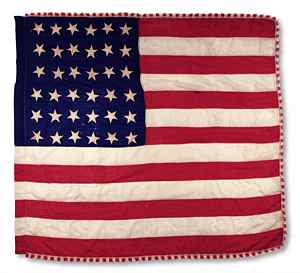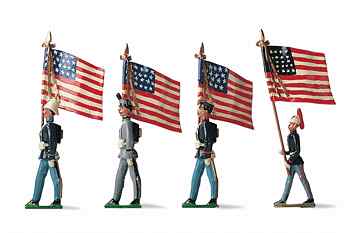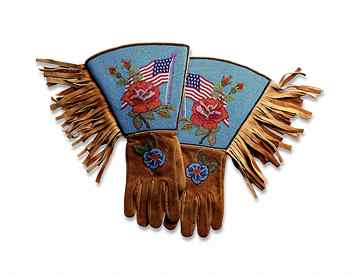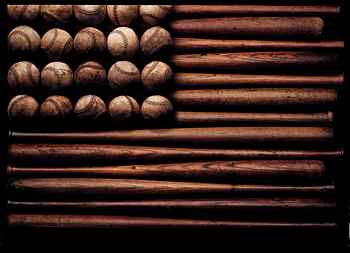Editor's note: The Nevada Museum of Art provided
source material to Resource Library for the following article or
essay. If you have questions or comments regarding the source material,
please contact the Nevada Museum of Art directly through either this phone
number or web address:
-
-
Long May She Wave: A Graphic
History of the American Flag
October 25, 2008 - February 22,
2009
The Nevada Museum
of Art will examine the design of the American flag in the exhibition Long
May She Wave: A Graphic History of the American Flag.  From Civil War-era flags and Native American moccasins
to political campaign buttons and heirloom quilts, Long May She Wave:
A Graphic History of the American Flag assembles thousands of American
flag-related objects and artifacts from the private collection of Kit Hinrichs,
one of the world's leading graphic designers and a partner in the international
design firm, Pentagram. Long May She Wave: A Graphic History of
the American Flag is scheduled for exhibition from October 25, 2008
through February 22, 2009 and is planned to coincide with the 2008 United
States presidential election. (left: Thirty-six-star flag, circa
1865, wool bunting with cotton stars)
From Civil War-era flags and Native American moccasins
to political campaign buttons and heirloom quilts, Long May She Wave:
A Graphic History of the American Flag assembles thousands of American
flag-related objects and artifacts from the private collection of Kit Hinrichs,
one of the world's leading graphic designers and a partner in the international
design firm, Pentagram. Long May She Wave: A Graphic History of
the American Flag is scheduled for exhibition from October 25, 2008
through February 22, 2009 and is planned to coincide with the 2008 United
States presidential election. (left: Thirty-six-star flag, circa
1865, wool bunting with cotton stars)
One of the most recognizable icons in the world today,
the American flag has enjoyed a long history of graphic renderings and artistic
re-interpretations. Although the Continental Congress agreed in 1777 that
the United States flag should be comprised of stars and stripes in red,
white, and blue, more than a century passed without formal design regulations
-- yielding a wealth of exuberant and unbridled creative manifestations
of the national banner. Far from being a static symbol, the flag has been
the subject of countless graphic interpretations over its 224-year history,
each version owing more to the personality of the maker than to established
formal conventions.
Nowhere are these continual changes better examined than
in the collection amassed by graphic designer Kit Hinrichs. In this unique
collection, "the flag is presented in an extraordinary array of celebratory,
ceremonial, political, commercial, and artistic settings," according
to Gerard C. Wertkin, Director of the American Folk Art Museum.
Themes examined in the exhibition include: the flag in
celebration, featuring items such as decorative ornaments, home items, and
sports memorabilia; the  flag
in commerce, as seen on magazine covers, product packaging and advertisements;
the flag in art and folk art, with crocheted flags, quilts and artists'
renderings; the flag at play, with wooden blocks, parade parasols, party
horns, and various toys; the flag in politics and protest, with posters,
buttons and miscellaneous campaign collateral; the flag in Native American
art, with woven blankets, beaded coin purses, gloves, and moccasins; and
the flag at war, with battle-flown flags from the Civil War and Korean Conflict,
as well as war medals and memorabilia ranging from pennants to whiskey flasks.
(right: Toy Soldier Flag Bearers, not dated, metal, ceramic, and composition
miniatures)
flag
in commerce, as seen on magazine covers, product packaging and advertisements;
the flag in art and folk art, with crocheted flags, quilts and artists'
renderings; the flag at play, with wooden blocks, parade parasols, party
horns, and various toys; the flag in politics and protest, with posters,
buttons and miscellaneous campaign collateral; the flag in Native American
art, with woven blankets, beaded coin purses, gloves, and moccasins; and
the flag at war, with battle-flown flags from the Civil War and Korean Conflict,
as well as war medals and memorabilia ranging from pennants to whiskey flasks.
(right: Toy Soldier Flag Bearers, not dated, metal, ceramic, and composition
miniatures)
A special feature included in the exhibition Long May
She Wave: A Graphic History of the American Flag, is a selection of
quilts ranging from a Centennial-era creation to a contemporary work designed
for the Lands' End catalogue.
United States patriotism and quilting have a long and close
history, often visually represented through the incorporation of the American
flag into the quilt designs. This connection is evident in several works
highlighted in the exhibition, including: the 36-star Log Cabin quilt (signifying
Nevada's statehood), as well as a Victorian-era Crazy quilt -- an exceptional
example of the quilting technique best known for its mosaic appearance and
randomly-shaped pieces.
Other highlighted works in the exhibition include a 36-star
flag circa 1865, a World War II-era work assembled from postage stamps and
U.S. Postal Service cancellation marks on envelopes, as well as buttons
and postcards from historic presidential campaigns.
Kit Hinrichs' collection of American flags and stars and
stripes memorabilia totals nearly 5,000 objects. Hinrichs is co-author of
several books, including Stars and Stripes, Vegetables and
Typewise. His work has been exhibited internationally and is in the
permanent collections of the Museums of Modern Art in New York and San Francisco.

(above: Lakota Gauntlet Gloves, circa 1960, glass beads
and leather)

(above: Terry Heffernan, Great American Sport, 1995,
color photograph)
Catalogue
This exhibition is accompanied by the book Long May
She Wave: A Graphic History of the American Flag, available for purchase
in The Store at the museum.
Selected wall texts for the exhibition
- Among the most recognizable icons in the world today,
the American flag has enjoyed a long history of graphic renderings and
artistic reinterpretations. Although the Continental Congress agreed in
1777 that the United States flag should be comprised of stars and stripes
in red, white, and blue, more than a century passed without formal design
regulations -- yielding a wealth of exuberant and unbridled creative manifestations
of the national banner.
-
- For millions of people, the American flag embodies the
values, ethics, strengths-and foibles-of the United States. It is a symbolic
icon that is loved and cherished by some and reviled by others. Countless
men and women have sworn allegiance to the flag -- and many have given
their lives defending the values it represents. Celebrated on battlefields
yet central to political protests, emblazoned on children's toys and stitched
into heirloom quilts, the Stars and Stripes has been continually reclaimed
by the American public.
-
- Long May She Wave: A Graphic History of the American
Flag assembles thousands of American flag-related
objects and artifacts from the private collection of Kit Hinrichs, one
of the world's leading graphic designers and a partner in the international
design firm, Pentagram. The range of objects presented comprise their own
genre of folk art and are a unique part of American heritage -- revealing
the history, culture, and political climate of the United States.
Collector's statement
- My family's only heirloom was a tattered and patched
thirty-six-star Civil War flag sewn by my great-great-great aunt, Ida Peppercorn,
in 1865. When I was in first grade, my mom allowed me to take this keepsake
to school for show-and-tell; it was my proudest moment that year. Decades
later, my parents asked me to be the family caretaker of this coveted flag,
and I hung it prominently in my first New York apartment.
-
- My interest in the Stars and Stripes could have ended
there, but as a designer, creating graphic symbols is an important aspect
of my work. The American flag was a symbol I couldn't leave alone. Designers
are continually challenged to come up with visual icons that evoke immediate
recognition, emotional power, and universal meaning. By any standard, the
American flag has brand value that every designer would envy.
-
- But the American flag is not only a recognizable symbol.
It is also one to which everyone, not only Americans, has a personal and
often visceral response. Over the past two hundred years, people have expressed
their feelings toward the United States through its flag. They have used
it to legitimize their causes, whether products or political campaigns.
-
- When I view my collection as a whole, I am fascinated
by the many forms the Stars and Stripes has taken over the decades. I have
found flags molded in Jell-O, carved in tree trunks, etched in granite,
and sprinkled with glitter. Through this parade of objects and imagery,
I've learned about the social milieus from which the various flag interpretations
emerged. It is not just the flag as a designed object that has intrigued
me; it is the rich history that surrounds it, too.
-
- For me, the collector's passion is in the joy of discovery
-- in sorting through piles of stuff at antique fairs and flea markets
and finally unearthing a new and wonderful iteration of the Stars and Stripes;
in learning about how people lived and thought in another time; and in
deepening my appreciation of the independent spirit and resourcefulness
of the true "designers" of the flag, the American people.
-
- Kit Hinrichs
Related programs
- E.L. Cord Museum School at the Nevada Museum of Art
- QUILTED CLOTHING
- Saturday, December 6 / 10 a.m. - 5 p.m.
- Bring your sewing machine and a favorite pattern to create
vibrant and stylish vests or jackets with quilter Jimmie Benedict. Learn
quilting techniques, and be inspired by the historic quilts featured in
the exhibit, Long May She Wave: A Graphic History of the American Flag.
Use pieced-together fabric to make wearable quilted clothing. Ages, cost
and details at nevadaart.org/school/schedule.php or 775.329.3333
-
- ARTBITE
- Needle Felting and Wool Appliqué in the Era of
the Civil War
- Friday, December 12 / 12 noon
- Sandi Sullivan, of Windy Moon Quilts in Reno, explains
the history and processes of wool needle felting and appliqué. Before
the advent of felting and quilting machines, women felted or spun raw wool
into material useful in the creation of flag-related art. Join her for
a rich discussion of this almost-forgotten art. Fee. Purchase tickets online
at www.nevadaart.org/tickets or at the Museum admissions desk.
Editor's note: RL readers may also enjoy:
Read more articles and essays concerning this source by
visiting the sub-index page for the Nevada Museum
of Art in Resource Library.
Search Resource
Library for thousands of articles and essays on American art.
Copyright 2008 Traditional Fine Arts Organization, Inc., an Arizona nonprofit corporation. All rights
reserved.
 From Civil War-era flags and Native American moccasins
to political campaign buttons and heirloom quilts, Long May She Wave:
A Graphic History of the American Flag assembles thousands of American
flag-related objects and artifacts from the private collection of Kit Hinrichs,
one of the world's leading graphic designers and a partner in the international
design firm, Pentagram. Long May She Wave: A Graphic History of
the American Flag is scheduled for exhibition from October 25, 2008
through February 22, 2009 and is planned to coincide with the 2008 United
States presidential election. (left: Thirty-six-star flag, circa
1865, wool bunting with cotton stars)
From Civil War-era flags and Native American moccasins
to political campaign buttons and heirloom quilts, Long May She Wave:
A Graphic History of the American Flag assembles thousands of American
flag-related objects and artifacts from the private collection of Kit Hinrichs,
one of the world's leading graphic designers and a partner in the international
design firm, Pentagram. Long May She Wave: A Graphic History of
the American Flag is scheduled for exhibition from October 25, 2008
through February 22, 2009 and is planned to coincide with the 2008 United
States presidential election. (left: Thirty-six-star flag, circa
1865, wool bunting with cotton stars) flag
in commerce, as seen on magazine covers, product packaging and advertisements;
the flag in art and folk art, with crocheted flags, quilts and artists'
renderings; the flag at play, with wooden blocks, parade parasols, party
horns, and various toys; the flag in politics and protest, with posters,
buttons and miscellaneous campaign collateral; the flag in Native American
art, with woven blankets, beaded coin purses, gloves, and moccasins; and
the flag at war, with battle-flown flags from the Civil War and Korean Conflict,
as well as war medals and memorabilia ranging from pennants to whiskey flasks.
(right: Toy Soldier Flag Bearers, not dated, metal, ceramic, and composition
miniatures)
flag
in commerce, as seen on magazine covers, product packaging and advertisements;
the flag in art and folk art, with crocheted flags, quilts and artists'
renderings; the flag at play, with wooden blocks, parade parasols, party
horns, and various toys; the flag in politics and protest, with posters,
buttons and miscellaneous campaign collateral; the flag in Native American
art, with woven blankets, beaded coin purses, gloves, and moccasins; and
the flag at war, with battle-flown flags from the Civil War and Korean Conflict,
as well as war medals and memorabilia ranging from pennants to whiskey flasks.
(right: Toy Soldier Flag Bearers, not dated, metal, ceramic, and composition
miniatures)
